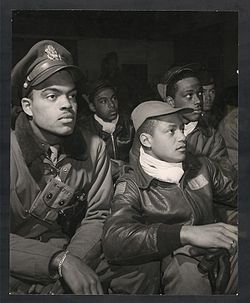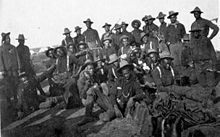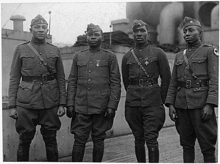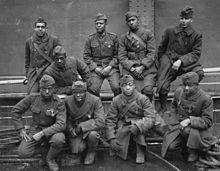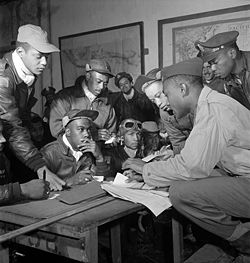- Military history of African Americans
-
The military history of African Americans spans from the arrival of the first black slaves during the colonial history of the United States to the present day. There has been no war fought by or within the United States in which African Americans did not participate, including the Revolutionary War, the War of 1812, the Mexican-American War, the Civil War, the Spanish American War, the World Wars, the Korean War, the Vietnam War, the Gulf War, and the wars in Afghanistan and Iraq, as well as other minor conflicts.
Revolutionary War
African American topics Atlantic slave trade · Maafa
Slavery in the United States
Reconstruction Era
Military history of African Americans
Jim Crow laws · Redlining
Great Migration
Civil Rights Movements 1896–1954 and
1955–1968
Second Great Migration
Afrocentrism
Post-Civil Rights era
Inauguration of Barack ObamaReligionBlack church
Black liberation theology
Black theology
Doctrine of Father Divine
American Society of Muslims
Nation of Islam
Black Hebrew Israelites
The Nation of Gods and Earths
Buddhist Nation
Spiritual Church MovementPolitical movementsSportsNegro league baseball
CIAA · SIAC · MEAC · SWACDiasporaLiberia · Nova Scotia · France
Sierra LeoneCategory · Portal 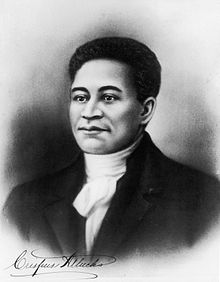 Crispus Attucks is seen by some as a patriot of the pre-Revolutionary War era. As part of a rioting mob, he was killed in 1770 during an attack on British soldiers guarding the custom house which came to be known as the Boston Massacre.
Crispus Attucks is seen by some as a patriot of the pre-Revolutionary War era. As part of a rioting mob, he was killed in 1770 during an attack on British soldiers guarding the custom house which came to be known as the Boston Massacre.
African-Americans as slaves and free blacks, served on both sides during the war. Black soldiers served in northern militias from the outset, but this was forbidden in the South, where slave-owners feared arming slaves. Lord Dunmore, the Royal Governor of Virginia, issued an emancipation proclamation in November 1775, promising freedom to runaway slaves who fought for the British; Sir Henry Clinton issued a similar edict in New York in 1779. Over 100,000 slaves escaped to the British lines, although possibly as few as 1,000 served under arms. Many of the rest served as orderlies, mechanics, laborers, servants, scouts and guides, although more than half died in smallpox epidemics that swept the British forces, and many were driven out of the British lines when food ran low. Despite Dunmore's promises, the majority were not given their freedom. Many Black Loyalists' descendants now live in Canada.
In response, and because of manpower shortages, Washington lifted the ban on black enlistment in the Continental Army in January 1776. All-black units were formed in Rhode Island and Massachusetts; many were slaves promised freedom for serving in lieu of their masters; another all-African-American unit came from Haiti with French forces. At least 5,000 African-American soldiers fought as Revolutionaries, and at least 20,000 served with the British.
Peter Salem and Salem Poor are the most noted of the African American Patriots during this era, while Black Loyalist Colonel Tye became one of the most successful commanders of the war.
Black volunteers also served with various of the South Carolina guerrilla units, including that of the "Swamp Fox", Francis Marion, half of whose force sometimes consisted of free Blacks. These Black troops made a critical difference in the fighting in the swamps, since they were immune to malaria through sickle-cell anemia, and kept Marion's guerrillas effective even when many of his White troops were down with malaria or yellow fever.
The first black American to fight in the Marines was John Martin, also known as Keto, the slave of a Delaware man, recruited in April 1776 without his owner's permission by Captain of the Marines Miles Pennington of the Continental brig USS Reprisal. Martin served with the Marine platoon on the Reprisal for a year and a half and took part in many ship-to-ship battles including boardings with hand-to-hand combat, but he was lost with the rest of his unit when the brig sank in October 1777.[1] At least 12 other black men served with various American Marine units in 1776–1777; more may have been in service but not identified as blacks in the records. However, in 1798 when the United States Marine Corps (USMC) was officially re-instituted, Secretary of War James McHenry specified in its rules: "No Negro, Mulatto or Indian to be enlisted".[1] Marine Commandant William Ward Burrows instructed his recruiters regarding USMC racial policy, "You can make use of Blacks and Mulattoes while you recruit, but you cannot enlist them."[1] This policy was in line with long-standing British naval practice which set a higher standard of unit cohesion for Marines so that they would remain loyal, maintain shipboard discipline and help put down mutinies.[1] The USMC maintained this policy until 1942.[2][3]
War of 1812
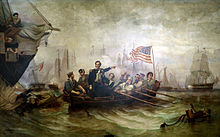 Painting of Battle of Lake Erie depicting one of Perry's African American oarsmen in the boat and another African American sailor in the water.[4]
Painting of Battle of Lake Erie depicting one of Perry's African American oarsmen in the boat and another African American sailor in the water.[4]
During the War of 1812, about one-quarter of the personnel in the American naval squadrons of the Battle of Lake Erie were black, and portrait renderings of the battle on the wall of the Nation's Capitol and the rotunda of Ohio's Capitol show that blacks played a significant role in it.
No legal restrictions regarding the enlistment of blacks were placed on the Navy because of its chronic shortage of manpower. The law of 1792, which generally prohibited enlistment of blacks in the Army became the United States Army's official policy until 1862. The only exception to this Army policy was Louisiana, which gained an exemption at the time of its purchase through a treaty provision, which allowed it to opt out of the operation of any law, which ran counter to its traditions and customs. Louisiana permitted the existence of separate black militia units which drew its enlistees from freed blacks.
A militia unit, The Louisiana Battalion of Free Men of Color, and a unit of black soldiers from Santo Domingo offered their services and were accepted by General Andrew Jackson in the Battle of New Orleans, a victory that was achieved after the war was officially over.[5]
Mexican War
A number of blacks in the Army during the Mexican War were servants of the officers who received government compensation for the services of their servants or slaves. Also, soldiers from the Louisiana Battalion of Free Men of Color participated in this war. Blacks also served on a number of naval vessels during the Mexican War, including the U.S.S. Treasure, and the U.S.S. Columbus.[5]
U.S. Civil War
The history of African Americans in the U.S. Civil War is marked by 186,097 (7,122 officers, 178,975 enlisted)[6] African American men, comprising 163 units, who served in the Union Army during the Civil War, and many more African Americans served in the Union Navy. Both free African Americans and runaway slaves joined the fight. On the Confederate side, blacks, both free and slave, were used for labor, but the issue of whether to arm them, and under what terms, became a major source of debate amongst those in the South. At the start of the war, a Louisiana Confederate militia unit composed of free blacks was raised, but never accepted into Confederate service. On March 13, 1865 the Confederate Congress enacted a statute to allow the enlistment of African Americans but fewer than fifty were ever recruited.[citation needed]
 A company of 4th USCT
A company of 4th USCT
Indian Wars
From the 1870s to the early 20th century, African American units were utilized by the United States Government to combat the Native Americans during the Indian Wars. Perhaps the most noted among this group were the Buffalo Soldiers:
- 9th Cavalry Regiment
- 10th Cavalry Regiment
- 24th Infantry Regiment
- 25th Infantry Regiment
- 27th Cavalry Regiment[7]
- 28th Cavalry Regiment[7][8][9]
At the end of the U.S. Civil War the army reorganized and authorized the formation of two regiments of black cavalry with the designations 9th and 10th U. S. Cavalry. Two regiments of infantry were formed at the same time. These units were composed of black enlisted men commanded by white officers such as Benjamin Grierson, and, occasionally, an African-American officer such as Henry O. Flipper.
From 1866 to the early-1890s these regiments served at a variety of posts in the southwest United States and Great Plains regions. During this period they participated in most of the military campaigns in these areas and earned a distinguished record. Thirteen enlisted men and six officers from these four regiments earned the Medal of Honor during the Indian Wars. In addition to the military campaigns, the "Buffalo Soldiers" served a variety of roles along the frontier from building roads to escorting the U.S. mail.
Spanish American War
After the Indian Wars ended in the 1890s, the regiments continued to serve and participated in the Spanish-American War (including the Battle of San Juan Hill), where five more Medals of Honor were earned.[10] They took part in the 1916 Punitive Expedition into Mexico and in the Philippine-American War. The Spanish-American War's General Shafter preferred his "Buffalo Soldiers" to their white counterparts.
Units
In addition to the African Americans who served in Regular Army units during the Spanish American War, five African American Volunteer Army units and seven African American National Guard units also served.
Volunteer Army:
- 7th United States Volunteer Infantry (Colored Troops)
- 8th United States Volunteer Infantry (Colored Troops)
- 9th United States Volunteer Infantry (Colored Troops)
- 10th United States Volunteer Infantry (Colored Troops)
- 11th United States Volunteer Infantry (Colored Troops)
National Guard:
- 3rd Alabama Volunteer Infantry (Colored Troops)
- 8th Illinois Volunteer Infantry (Colored Troops)[11]
- Companies A and B, 1st Indiana Volunteer Infantry (Colored Troops)
- 23rd Kansas Volunteer Infantry (Colored Troops)
- 3rd North Carolina Volunteer Infantry (Colored Troops)
- 9th Ohio Volunteer Infantry (Colored Troops)
- 6th Virginia Volunteer Infantry (Colored Troops)
Of these units, only the 9th U.S., 8th Illinois, and 23rd Kansas served outside the United States during the war. All three units served in Cuba and suffered no losses to combat.
World War I
The U.S. armed forces remained segregated through World War I. Still, many African Americans eagerly volunteered to join the Allied cause following America's entry into the war. By the time of the armistice with Germany on November 1918, over 350,000 African Americans had served with the American Expeditionary Force on the Western Front.
Most African American units were largely relegated to support roles and did not see combat. Still, African Americans played a notable role in America's war effort. One of the most distinguished units was the 369th Infantry Regiment, known as the "Harlem Hellfighters", which was on the front lines for six months, longer than any other American unit in the war. 171 members of the 369th were awarded the Legion of Merit.
Corporal Freddie Stowers of the 371st Infantry Regiment that was seconded to the 157th French Army division called the Red Hand Division in need of reinforcement under the command of the General Mariano Goybet was posthumously awarded a Medal of Honor[12]—the only African American to be so honored for actions in World War I. During action in France, Stowers had led an assault on German trenches, continuing to lead and encourage his men even after being twice wounded. Stowers died from his wounds, but his men continued the fight and eventually defeated the German troops. Stowers was recommended for the Medal of Honor shortly after his death, but the nomination was, according to the Army, misplaced. Many believed that the recommendation was intentionally ignored due to institutional racism in the Armed Forces. In 1990, under pressure from Congress, the Department of the Army launched an investigation. Based on findings from this investigation, the Army Decorations Board approved the award of the Medal of Honor to Stowers. On April 24, 1991–73 years after he was killed in action—Stowers' two surviving sisters received the Medal of Honor from President George H.W. Bush at the White House. The success of the investigation leading to Stowers' Medal of Honor later sparked a similar review that resulted in six African Americans being posthumously awarded the Medal of Honor for actions in World War II. Vernon Baker was the only recipient who was still alive to receive his award.[13]
Units
Some of the most notable African American units which served in World War I were:
- 92nd Infantry Division
- 93rd Infantry Division
- 369th Infantry Regiment ("Harlem Hellfighters"; formerly the 15th New York National Guard)
- 370th Infantry Regiment (formerly the 8th Illinois)[14][15]
- 371st Infantry Regiment
- 372nd Infantry Regiment
A complete list of African-American units that served in the war is published in the book Willing Patriots: Men of Color in World War One. The book is cited in the "Further Reading" section of this article.
Period between the world wars
Even though the U.S. government was nominally neutral in the wars waged by Fascists against Ethiopia and Fascists and Nazis against the Spanish Republic in the mid 1930s, African Americans found it hard to be neutral and many became Antifascist.[16]
Second Italo-Abyssinian War
On October 4, 1935, Fascist Italy invaded Ethiopia. Being the only non-colonized African country besides Liberia, the invasion of Ethiopia caused a profound response amongst African Americans.[17] African Americans organized to raise money for medical supplies, and many volunteered to fight for the African kingdom.[18] Within eight months, however, Ethiopia was overpowered by the advanced weaponry and mustard gas of the Italian forces.
Many years later Haile Selassie I would comment on the efforts: "We can never forget the help Ethiopia received from Negro Americans during the crisis...It moved me to know that Americans of African descent did not abandon their embattled brothers, but stood by us."[18]
Spanish Civil War
When General Franco rebelled against the newly-established secular Spanish Republic, a number of African Americans volunteered to fight for Republican Spain. Many African Americans who were in the Abraham Lincoln Brigade had Communist ideals. Among these, there was Vaughn Love who went to fight for the Spanish loyalist cause because he considered Fascism to be the "enemy of all black aspirations."
African-American activist and World War I veteran Oliver Law, fighting in the Abraham Lincoln Brigade during the Spanish Civil War, is believed to have been the first African-American officer to command an integrated unit of soldiers.[19]
James Peck was an African American man from Pennsylvania who was turned down when he applied to become a military pilot in the US. He then went on to serve in the Spanish Republican Air Force until 1938.[20] Peck was credited with shooting down 5 Aviación Nacional planes, 2 Heinkel He-51s from the Legion Condor and 3 Fiat CR.32 Fascist Italian fighters. But there are sources claiming that he shot down only one.[21]
Salaria Kee was a young African American nurse from Harlem Hospital who served as a military nurse with the American Medical Bureau in the Spanish Civil War. She was one of the two only African American female volunteers in the midst of the war-torn Spanish Republican areas.[22] When Salaria came back from Spain she wrote the pamphlet ‘A Negro Nurse in Spain’ and tried to raise funds for the beleaguered Spanish Republic.[23]
World War II
We call upon the president and congress to declare war on Japan and racial prejudice in our country. Certainly we should be strong enough to whip them both.
The Pittsburgh Courier[24]Despite a high enlistment rate in the U.S. Army, African Americans were not treated equally. Racial tensions existed. At parades, church services, in transportation and canteens the races were kept separate.
Many soldiers of color served their country with distinction during World War II. There were 125,000 African Americans who were overseas in World War II. Famous segregated units, such as the Tuskegee Airmen and 761st Tank Battalion proved their value in combat, leading to desegregation of all U.S. Armed Forces by order of President Harry S. Truman in July 1948 via Executive Order 9981.
Benjamin O. Davis, Jr. served as commander of the famed Tuskegee Airmen during the War. He later went on to become the first African American general in the United States Air Force. His father, Benjamin O. Davis, Sr., had been the first African American Brigadier General in the Army (1940).
Doris Miller, a Navy mess attendant, was the first African American recipient of the Navy Cross, awarded for his actions during the attack on Pearl Harbor. Miller had voluntarily manned an anti-aircraft gun and fired at the Japanese aircraft, despite having no prior training in the weapon's use.
In 1944, the Golden Thirteen became the Navy's first African American commissioned officers. Samuel L. Gravely, Jr. became a commissioned officer the same year; he would later be the first African American to command a US warship, and the first to be an admiral.
The Port Chicago disaster on July 17, 1944, was an explosion of about 2,000 tons of ammunition as it was being loaded onto ships by black Navy soldiers under pressure from their white officers to hurry. The explosion in Northern California killed 320 military and civilian workers, most of them black. The aftermath led to the Port Chicago Mutiny, the only case of a full military trial for mutiny in the history of the U.S. Navy against 50 Afro-American sailors who refused to continue loading ammunition under the same dangerous conditions. The trial was observed by the then young lawyer Thurgood Marshall and ended in conviction of all of the defendants. The trial was immediately and later criticized for not abiding by the applicable laws on mutiny, and it became influential in the discussion of desegregation.
In 1945, Frederick C. Branch became the first African-American United States Marine Corps officer.
Units
 The Tuskegee Airmen were the first African-American pilots in United States military history; they flew with distinction during World War II. Portrait of Tuskegee airman Edward M. Thomas by photographer Toni Frissell, March 1945.
The Tuskegee Airmen were the first African-American pilots in United States military history; they flew with distinction during World War II. Portrait of Tuskegee airman Edward M. Thomas by photographer Toni Frissell, March 1945.
 12th AD soldier with German prisoners of war, April 1945.
12th AD soldier with German prisoners of war, April 1945.
Some of the most notable African American Army units which served in World War II were:
- 92nd Infantry Division
- 93rd Infantry Division
- 369th Infantry Regiment
- 370th Infantry Regiment
- 371st Infantry Regiment
- 2nd Cavalry Division
- 4th Cavalry Brigade
- 5th Cavalry Brigade
- 27th Cavalry Regiment
- 28th Cavalry Regiment
- Air Corps Units
- Non Divisional Units
- Infantry Units
- Cavalry/Armor Units
- US Military Academy Cavalry Squadron
- 5th Reconnaissance Squadron
- 758th Tank Battalion
- 761st Tank Battalion
- 784th Tank Battalion
- Field Artillery Units
- 46th Field Artillery Brigade.[25]
- 184th Field Artillery Regiment, Illinois National Guard.
- 333rd Field Artillery Regiment.[26]
- 349th Field Artillery Regiment[27]
- 350th Field Artillery Regiment[28]
- 351st Field Artillery Regiment[29]
- 353rd Field Artillery Regiment[30]
- 578th Field Artillery Regiment[31]
-
-
- 333rd Field Artillery Battalion
- 349th Field Artillery Battalion
- 350th Field Artillery Battalion
- 351st Field Artillery Battalion
- 353rd Field Artillery Battalion
- 578th Field Artillery Battalion
- 593rd Field Artillery Battalion
- 594th Field Artillery Battalion
- 595th Field Artillery Battalion
- 596th Field Artillery Battalion
- 597th Field Artillery Battalion
- 598th Field Artillery Battalion
- 599th Field Artillery Battalion
- 600th Field Artillery Battalion
- 686th Field Artillery Battalion
- 777th Field Artillery Battalion
- 795th Field Artillery Battalion
- 930th Field Artillery Battalion, Illinois National Guard
- 931st Field Artillery Battalion, Illinois National Guard
- 969th Field Artillery Battalion
- 971st Field Artillery Battalion
- 973rd Field Artillery Battalion
- 993rd Field Artillery Battalion
- 999th Field Artillery Battlaion
-
-
- Tank Destroyer Units
- 614th Tank Destroyer Battalion
- 646th Tank Destroyer Battalion
- 649th Tank Destroyer Battalion
- 659th Tank Destroyer Battalion
- 669th Tank Destroyer Battalion
- 679th Tank Destroyer Battalion
- 795th Tank Destroyer Battalion
- 827th Tank Destroyer Battalion
- 828th Tank Destroyer Battalion
- 829th Tank Destroyer Battalion
- 846th Tank Destroyer Battalion
- Tank Destroyer Units
Two segregated units were organized by the United States Marine Corps:
Medal of Honor recipients
Main article: List of African American Medal of Honor recipientsOn January 13, 1997, President Bill Clinton, in a White House ceremony, awarded the nation's highest military honor—the Medal of Honor—to seven African-American servicemen who had served in World War II.[32]
The only living recipient was:
- First Lieutenant Vernon Baker.
The posthumous recipients were:
- Major Charles L. Thomas
- First Lieutenant John R. Fox
- Staff Sergeant Ruben Rivers
- Staff Sergeant Edward A. Carter, Jr.
- Private First Class Willy F. James, Jr.
- Private George Watson
Blue discharges
Main article: Blue dischargeAfrican American troops faced discrimination in the form of the disproportionate issuance of blue discharges. The blue discharge (also called a "blue ticket") was a form of administrative discharge created in 1916 to replace two previous discharge classifications, the administrative discharge without honor and the "unclassified" discharge. It was neither honorable nor dishonorable.[33] Of the 48,603 blue discharges issued by the Army between December 1, 1941 and June 30, 1945, 10,806 were issued to African Americans. This accounts for 22.2% of all blue discharges, when African Americans made up just 6.5% of the Army in that time frame.[34] Blue discharge recipients frequently faced difficulties obtaining employment[35] and were routinely denied the benefits of the G. I. Bill by the Veterans Administration (VA).[36] In October 1945, Black-interest newspaper The Pittsburgh Courier launched a crusade against the discharge and its abuses. Calling the discharge "a vicious instrument that should not be perpetrated against the American Soldier", the Courier rebuked the Army for "allowing prejudiced officers to use it as a means of punishing Negro soldiers who do not like specifically unbearable conditions". The Courier specifically noted the discrimination faced by homosexuals, another group disproportionately discharged with blue tickets, calling them "'unfortunates' of the Nation...being preyed upon by the blue discharge" and demanded to know "why the Army chooses to penalize these 'unfortunates' who seem most in need of Army benefits and the opportunity to become better citizens under the educational benefits of the GI Bill of Rights".[37] The Courier printed instructions on how to appeal a blue discharge and warned its readers not to quickly accept a blue ticket out of the service because of the negative effect it would likely have on their lives.[38]
The House Committee on Military Affairs held hearings in response to the press crusade, issuing a report in 1946 that sharply criticized its use and the VA for discriminating against blue discharge holders.[39] Congress discontinued the blue discharge in 1947,[40] but the VA continued its practice of denying G. I. Bill benefits to blue-tickets.[36]
Integration of the armed forces
On July 26, 1948, President Harry S. Truman signed Executive Order 9981 integrating the military and mandating equality of treatment and opportunity. It also made it illegal, per military law, to make a racist remark. Desegregation of the military was not complete for several years, and all-black Army units persisted well into the Korean War. The last all-black unit wasn't disbanded until 1954.
In 1950, Lieutenant Leon Gilbert of the still-segregated 24th Infantry Regiment was court martialed and sentenced to death for refusing to obey the orders of a white officer while serving in the Korean War. Gilbert maintained that the orders would have meant certain death for himself and the men in his command. The case led to worldwide protests and increased attention to segregation and racism in the U.S. military. Gilbert's sentence was commuted to twenty and later seventeen years of imprisonment; he served five years and was released.
The integration commanded by Truman's 1948 Executive Order extended to schools and neighborhoods as well as military units. Fifteen years after the Executive Order, Secretary of Defense Robert McNamara issued Department of Defense Directive 5120.36. "Every military commander", the Directive mandates, "has the responsibility to oppose discriminatory practices affecting his men and their dependents and to foster equal opportunity for them, not only in areas under his immediate control, but also in nearby communities where they may gather in off-duty hours."[41] While the directive was issued in 1963, it was not until 1967 that the first non-military establishment was declared off-limits. In 1970 the requirement that commanding officers first obtain permission from the Secretary of Defense was lifted, and areas were allowed to be declared housing areas off limits to military personnel by their commanding officer.[42]
Korean War
Jesse L. Brown became the U.S. Navy's first black aviator in October 1948. He was killed when his plane was shot down during the Battle of Chosin Reservoir in North Korea. He was unable to eject from his crippled F4U Corsair and crash-landed successfully. His injuries and damage to his aircraft prevented him from leaving the plane. A white squadron mate, Thomas Hudner, crash-landed his F4U Corsair near Brown and attempted to extricate Brown but could not and Brown died of his injuries. Hudner was awarded the Medal of Honor for his efforts. The U.S. Navy honored Jesse Brown by naming an escort ship after him—the U.S.S. Jesse L. Brown.[43]
Two enlisted men from the 24th Infantry Regiment (still a segregated unit), Cornelius H. Charlton and William Thompson, posthumously received the Medal of Honor for actions during the war.
Vietnam War
The Vietnam War saw many great accomplishments by many African Americans, including twenty who received the Medal of Honor for their actions. African Americans during the conflict suffered casualty rates slightly higher than their percentage of the total population.[44]
In 1967, President Lyndon B. Johnson presented the Medal of Honor to U.S. Army Specialist Five Lawrence Joel, for a "very special kind of courage—the unarmed heroism of compassion and service to others." Joel was the first living African American to receive the Medal of Honor since the Mexican–American War. He was a medic who in 1965 saved the lives of U.S. troops under ambush in Vietnam and defied direct orders to stay to the ground, walking through Viet Cong gunfire and tending to the troops despite being shot twice himself. The Lawrence Joel Veterans Memorial Coliseum in Winston-Salem, North Carolina is dedicated to his honor.[45]
On August 21, 1968, with the posthumous award of the Medal of Honor, U.S. Marine James Anderson, Jr. became the first African-American U.S. Marine recipient of the Medal of Honor for his heroic actions and sacrifice of life.
On December 10, 1968, U.S. Army Captain Riley Leroy Pitts became the first African American commissioned officer to be awarded the Medal of Honor. His medal was presented posthumously to his wife, Mrs. Eula Pitts, by President Lyndon B. Johnson.
Post-Vietnam to present day
Further information: Gulf War and War in IraqIn 1989, President George H. W. Bush appointed Army General Colin Powell to the position of Chairman of the Joint Chiefs of Staff, making Powell the highest ranking officer in the United States military. Powell was the first, and is so far the only, African American to hold that position. The Chairman serves as the chief military adviser to the President and the Secretary of Defense. During his tenure Powell oversaw the 1989 United States invasion of Panama to oust General Manuel Noriega and the 1990 to 1991 Gulf War against Iraq. General Powell's four-year term as Chairman ended in 1993.
General William E. "Kip" Ward was officially nominated as the first commander of the new United States Africa Command on July 10, 2007 and assumed command on October 1, 2007.
The current Sergeant Major of the Marine Corps, Carlton W. Kent, is African American; as were the previous two before him.
The American military and Affirmative Action
Since the end of military segregation and the creation of an all-volunteer army, the American military has seen the representation of African Americans in its ranks rise precipitously.[46]
Military history of African Americans in popular culture
The following is a list of notable African American military members or units in popular culture.
Release Date (or Year) Name (or event) Notability Reference 1945 Wings for This Man a "propaganda" short about the Tuskegee Airmen was produced by the First Motion Picture Unit of the Army Air Forces. The film was narrated by Ronald Reagan. [47] 1989 Glory film featuring the 54th Union regiment composed of African American soldiers. Starring Denzel Washington and Matthew Broderick 1990 The Court-Martial of Jackie Robinson A film about the early life of the baseball star in the army, particularly his court-martial for insubordination regarding segregation. January 31, 1992 Family Matters
ABC TV seriesIn the episode entitled "Brown Bombshell", Estelle (portrayed by actress Rosetta LeNoire) is determined to share the stories of her late fighter-pilot husband and World War II's Tuskegee Airmen to an uninterested Winslow clan. Eventually, she is invited to share her stories to Eddie's American history class. [48] 1996 The Tuskegee Airmen Produced and aired by HBO and starring Laurence Fishburne. [49] 1997 G.I. Joe action figure series The Tuskegee Airmen are represented. [50] 1999 Mutiny TV made film of the 1944 Port Chicago disaster 2001-2005 JAG The Commander Peter Ulysses Sturgis Turner (played by Scott Lawrence) is an African-American navy Officer in the JAG TV series. Former submarine officer, he serves now as lawyer in JAG 2002 JAG: "Port Chicago" The television drama features the incident 2002 Hart's War a film about a World War II prisoner of war (POW) based on the novel by John Katzenbach 2004 Silver Wings and Civil Rights: The Fight to Fly this documentary film was the first film to feature information regarding the "Freeman Field Mutiny", the struggle of 101 African-American officers arrested for entering a white officer's club. [51] May 17, 2005 Red Tails George Lucas announced he was planning a film about the Tuskegee Airmen. In his release Lucas says, "They were the only escort fighters during the war that never lost a bomber so they were, like, the best." [52] Wild Blue Book, by Stephen Ambrose where the Tuskegee Airmen were mentioned and honored. [53] Willy's Cut & Shine a play by Michael Bradford depicting African American World War II soldiers and the troubles they encounter upon returning home to the Deep South. 2010 For Love of Liberty a PBS documentary television series that portrays African-American servicemen and women and their dedicated allegiance to the United States military. [54] See also
- Military history of the United States
- United States Colored Troops
- List of African American Medal of Honor recipients
- Frederick C. Branch
- Benjamin O. Davis
- Martin Delany
- Daniel "Chappie" James, Jr.
- National Association for Black Veterans
- List of African-American astronauts
- African-American discrimination in the U.S. Military
Notes
- ^ a b c d Shaw, Henry I., Jr.; Donnelly, Ralph W. (2002). "Blacks in the Marine Corps". Washington, DC: History and Museums Division, Headquarters USMC. http://www.marines.mil/news/publications/Documents/Blacks%20in%20the%20Marine%20Corps%20%20PCN%2019000306200_1.pdf. Retrieved June 1, 2011.
- ^ Morris, Steven (December 1969). "How Blacks Upset The Marine Corps: 'New Breed' leathernecks are tackling racist vestiges". Ebony (Johnson Publishing Company) 25 (2): 55–58. ISSN 0012-9011. http://books.google.com/books?id=7qA975ldsm4C&pg=PA58.
- ^ MacGregor, Morris J. (1981). Center of Military History, U.S. Army. ed. Integration of the Armed Forces, 1940–1965. Government Printing Office. pp. 100–102. ISBN 0160019257. http://books.google.com/books?id=RIsbUaQf-DkC&pg=PA100.
- ^ U.S. Senate: Art & History Home > Battle of Lake Erie
- ^ a b African American History & the Civil War(CWSS)
- ^ Herbert Aptheker Negro Casualties in the Civil War The Journal of Negro History, Vol. 32, No. 1. (Jan., 1947), pp. 12.
- ^ a b "Historic California Posts: Camp Lockett". http://www.militarymuseum.org/CpLockett.html. Retrieved 2008-01-17
- ^ "The 28th Cavalry: The U.S. Army's Last Horse Cavalry Regiment". http://www.buffalosoldiers-lawtonftsill.org/28-cav.htm. Retrieved 2007-04-24
- ^ "Defending the Border: The Cavalry at Camp Lockett". http://www.sandiegohistory.org/journal/93spring/border.htm. Retrieved 2008-01-17
- ^ Heitland, Jason. "The Role of the Buffalo Soldiers During the Plains Indian Wars". http://www.us7thcavcof.com/GCompany.html. http://www.us7thcavcof.com/BuffaloSoldiers.html. Retrieved 12 July 2011.
- ^ McCard, Harry Stanton; Turnley, Henry (1899). History of the Eighth Illinois United States Volunteers. Chicago: E. F. Harman & Co.. http://www.archive.org/details/historyofeighthi00mcca
- ^ Freddie Stowers,Corporal, United States Army
- ^ "African American World War II Medal of Honor Recipients". U.S. Army Center of Military History. 2011–02–03 [last update]. http://www.history.army.mil/html/moh/mohb.html. Retrieved July 18, 2011-07-18.
- ^ Unknown (1919). Complete History of the Colored Soldiers in the World War. New York: Bennett & Churchill
- ^ Sweeney, W. Allison (1919). "History of the American Negro in the Great World War". http://www.gutenberg.org/etext/16598
- ^ African Americans in the Spanish Civil War: "This Ain't Ethiopia, But It'll Do." Edited by Danny Duncan Collum. Victor A. Berch, chief researcher. New York: G.K. Hall and Co., 1992.
- ^ Aric Putnam Ethiopia is Now:J. A. Rogers and the Rhetoric of Black Anticolonialism During the Great Depression Rhetoric & Public Affairs - Volume 10, Number 3, Fall 2007, p. 419
- ^ a b Gerald A. Danzer, J. Jorge Klor De Alva, Larry S. Krieger (2003). The Americans: Reconstruction to the 21st Century. McDougal Littell.
- ^ Rowley, Hazel (2008). Richard Wright: The Life and Times. University of Chicago Press. p. 97. ISBN 0226730387. http://books.google.com/?id=uvbJ-FhhLNgC.
- ^ Abraham Lincoln Brigade - James Peck
- ^ Michael Lee Lanning, The African-American Soldier: From Crispus Attucks to Colin Powell, Birch Lane Press, 1997. ISBN 1559724048
- ^ Gail Lumet Buckley, American Patriots: The Story of Blacks in the Military from the Revolution to Desert Storm, ISBN 9780375502798
- ^ Reilly, Salaria Kee (1913-1991)
- ^ The Pittsburgh Courier December 13, 1941 pg. 1
- ^ Unit subsequently reorganized and redesignated the 46th Field Artillery Group.
- ^ Unit subsequently reorganized and redesignated as the 333rd Field Artillery Group.
- ^ Unit subsequently reorganized and redesignated as the 349th Field Artillery Group.
- ^ Unit subsequently reorganized and redesignated as the 350th Field Artillery Regiment
- ^ Unit subsequently reorganized and redesignated the 351st Field Artillery Group.
- ^ Subsequently, unit reorganized and redesignated the 353rd Field Artillery Group
- ^ Unit subsequently reorganized and redesignated the 578th Field Artillery Group
- ^ "World War II African American Medal of Honor Recipients". United States Army Center of Military History. http://www.history.army.mil/html/moh/mohb.html.
- ^ Jones, p. 2
- ^ McGuire, p. 146
- ^ Shilts, p. 164
- ^ a b Bérubé, p. 230
- ^ Quoted in Bérubé, p. 233
- ^ Bérubé, p. 241
- ^ Bérubé, p. 234
- ^ Associated Press (1947-05-21). "Army to abandon 'blue' discharge". Jefferson City (MO) Daily Capital News: p. 1.
- ^ Department of Defense Directive 5120.36
- ^ Heather Antecol and Deborah Cobb-Clark, Racial and Ethnic Harassment in Local Communities. October 4, 2005. p 8
- ^ "USS Jesse L. Brown". Naval Historical Center, Department of the Navy. http://www.history.navy.mil/photos/sh-usn/usnsh-j/de1089.htm.
- ^ Michael Kelley (July 1998). "Myths & Misconceptions: Vietnam War Folklore". The Vietnam Conflict. De Anza College. http://www.deanza.edu/faculty/swensson/essays_mikekelley_myths.html. Retrieved 2 March 2011.
- ^ "Who is Lawrence Joel?". Lawrence Joel Veterans Memorial Coliseum - Winston-Salem, North Carolina. http://www.ljvm.com/lawrencejoel.html. Retrieved 2007-01-13.
- ^ John Sibley Butler. Affirmative Action in the Military Annals of the American Academy of Political and Social Science, Vol. 523, Affirmative Action Revisited (Sep., 1992), pg. 196.
- ^ Wings for This Man at the Internet Movie Database
- ^ "TV.com Family Matters Episodes: Season 3". http://www.tv.com/family-matters/show/474/episode_guide.html?season=3&tag=season_dropdown;dropdown;2. Retrieved 2007-01-01.
- ^ The Tuskegee Airmen at the Internet Movie Database
- ^ 1997 G.I. Joe Classic Collection
- ^ Siver Wings and Civil Rights: The Flight to Fly
- ^ Exclusive: Lucas looks to the future
- ^ Ambrose, Stephen Edward The Wild Blue: the men and boys who flew the B-24s over Germany, Simon and Schuster, 2001, Chapter 9, p. 27
- ^ For Love of Liberty
References
- Bérubé, Allan (1990). Coming Out Under Fire: The History of Gay Men and Women in World War Two. New York, The Penguin Group. ISBN 0452265983 (Plume edition 1991).
- Jones, Major Bradley K. (January 1973). "The Gravity of Administrative Discharges: A Legal and Empirical Evaluation" The Military Law Review 59:1–26.
- McGuire, Phillip (ed.) (1993). Taps for a Jim Crow Army: Letters from Black Soldiers in World War II. University Press of Kentucky. ISBN 0813108225.
- Shilts, Randy (1993). Conduct Unbecoming: Gays & Lesbians in the U.S. Military Vietnam to the Persian Gulf. New York, St. Martin's Press. ISBN 031209261X
Further reading
- Dalessandro, Robert J.; Gerald Torrence (2009). Willing Patriots: Men of Color in the First World War. Schiffer. ISBN 978-0-7643-3233-3.
- Gibson, Truman K., Jr.; Steve Huntley (2005). Knocking Down Barriers: My Fight for Black America. Northwestern University Press. ISBN 0-8101-2292-8. http://www.nupress.northwestern.edu/title.cfm?ISBN=0-8101-2292-8.
- Höhn, Maria; Martin Klimke (2010). A Breath of Freedom: The Civil Rights Struggle, African American GIs, and Germany. Palgrave Macmillan. ISBN 978-0230104730.
- Miller, Richard E. (2004). The Messman Chronicles: African Americans in the U.S. Navy, 1932–1943. Naval Institute Press. ISBN 1-55750-539-X.
External links
- "African Americans in the U.S. Army". U.S. Army. http://www.army.mil/africanamericans/.
- "Story of America's Black Patriots". U.S. Army. http://www.forloveofliberty.net.
- Simpson, Diana (compiled by) (February 1999). "African-Americans in Military History". Air University Library, Maxwell Air Force Base. http://www.au.af.mil/au/aul/bibs/afhist/aftoc.htm.
- "Black History at Arlington National Cemetery". Historical Information. Arlington National Cemetery. http://www.arlingtoncemetery.org/historical_information/black_history.html. Retrieved 2007-07-04.
- Black Confederates documentary book
- "Black Military World". http://www.blackmilitaryworld.com/.
- "Black Military History: African Americans in the service of their country". Father Ryan High School. http://www.fatherryan.org/blackmilitary/.
- "A Chronology of African American Military Service: From the Colonial Era through the Antebellum Period". http://www.ufphq.com/aams.htm.
- First Kansas Colored Infantry flag, Civil War, Kansas Museum of History
- The "Colored" Soldiers, Kansas Historical Society
Leadership - Commander-in-chief: President of the United States
- Secretary of Defense
- Deputy Secretary of Defense
- Joint Chiefs of Staff (Chairman)
- United States Congress: Committees on Armed Services:
- Active duty four-star officers
- Highest ranking officers in history
- National Security Act of 1947
- Goldwater–Nichols Act
Organization BranchesReserve componentsStructure - United States Code
- The Pentagon
- Installations
- Budget
- Units:
- Logistics
- Media
Operations and history - Current deployments
- Conflicts
- Wars
- Timeline
- History:
- Colonial
- WWII
- Civil affairs
- African Americans
- Asian Americans
- Jewish Americans
- Sikh Americans
- Historiography:
- Art:
- A
- AF
Personnel TrainingOther- Oath:
- Creeds & Codes:
- Service numbers:
- A
- MC
- N
- AF
- CG
- Military Occupational Specialty/Rating/Air Force Specialty Code
- Pay
- Uniform Code of Military Justice
- Judge Advocate General's Corps
- Military Health System/TRICARE
- Separation
- Veterans Affairs
- Conscription
- Chiefs of Chaplains:
Equipment LandSeaAirOtherLegend: A = Army, MC = Marine Corps, N = Navy, AF = Air Force, CG = Coast Guard, PHS = Public Health Service, NOAA = National Oceanic and Atmospheric Administration, MSC = Military Sealift CommandUnited States in World War II Home Front American music during World War II • United States aircraft production during World War II • Greatest Generation
American WomenWomen Airforce Service Pilots • Women's Army Corps• Woman's Land Army of America • Rosie the RiveterMilitary participation Army (Uniforms) • Army Air Force • Marine Corps • Navy • Service medals (Medal of Honor recipients)
EventsList of Battles • Attack on Pearl Harbor • Normandy landings • Atomic bombings of Hiroshima and NagasakiMinoritiesDiplomatic participation Categories:- Black history in the United States military
- Buffalo Soldiers
- History of racial segregation in the United States
- Military history of the United States
Wikimedia Foundation. 2010.

